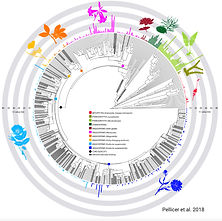Arezoo Dastpak
(Florida International University)

Research Areas:
-
Genome Size Evolution
-
Plant Functional Traits and Adaptation
-
Leaf Anatomy and Stomatal Biology
-
Evolutionary Systematics and Phylogenetics
Importance of Genome Size and the Evolution of Plant Form and Function
Genome size (1C-value), the amount of DNA in a haploid nucleus, is a key factor shaping plant form, function, and evolution. Variation in genome size, driven by polyploidy, transposable elements, and genome downsizing, provides insights into the evolutionary history and diversification of plant lineages.
Functionally, genome size influences cell and tissue traits, such as cell size, stomatal
density, and growth rates, thereby affecting ecological strategies and adaptation. Smaller
genomes are generally linked to faster growth and greater plasticity, while larger genomes
correlate with slower development and specialization in stable environments.
In systematics and taxonomy, genome size aids in species delimitation, hybrid detection,
and phylogenetic inference.
In plant breeding and genomics, genome size informs sequencing strategies,facilitates
ploidy assessment and inheritance studies, and supports the development
of improved cultivars.
Additionally, genome size is relevant in invasion biology, where smaller genomes are often associated with traits that enhance invasiveness. Its practical importance also extends to selecting model organisms with compact genomes for genomic studies.
Integrating genome size data with functional and phylogenomic research continues to advance our understanding of plant biodiversity, evolution, and applied biology.

My research investigates how variation in genome size influences plant structure, function, and adaptation. Genome size, though often overlooked, has profound impacts on cellular architecture, physiological processes, and ecological strategies. It governs key traits such as cell size, division rate, resource allocation, and ultimately shapes leaf anatomy, stomatal function, photosynthetic efficiency, and environmental responses.
Working at the intersection of evolutionary biology and ecological genomics, I explore foundational questions about the developmental, physiological, and evolutionary consequences of genome size diversity across plant lineages, particularly in tropical and subtropical species. My approach integrates flow cytometry, light and confocal microscopy, and comparative phylogenetic analyses.
Key Focus Areas:
1. Evolutionary Consequences of Genome Size Variation
I examine how genome size affects traits such as epidermal cell size, stomatal density, and gas exchange capacity, and how these traits influence photosynthesis and environmental adaptation. Genome size data are combined with anatomical and phylogenetic analyses to uncover functional trade-offs and macroevolutionary patterns.
2. Trait Evolution in Lineages with Extreme Genome Sizes
By studying species with exceptionally large or small genomes, I investigate how genome architecture drives developmental flexibility, leaf form, and stress responses. These "genomic extremes" provide insight into how plants navigate physiological constraints and evolve novel adaptive strategies.






All images and histograms were generated during my postdoctoral research in Dr. Roddy's Lab. Explore more by genus name in Photos!